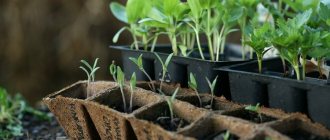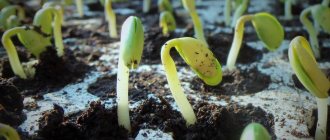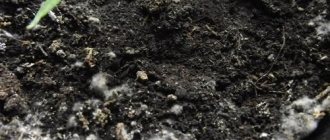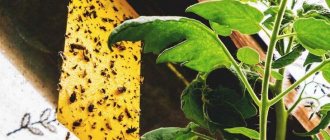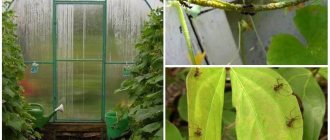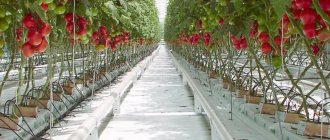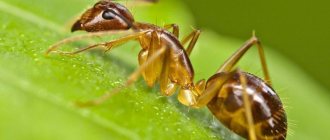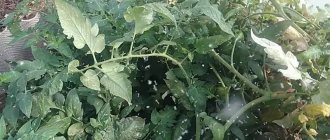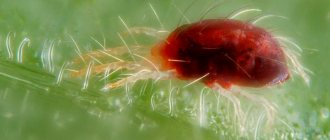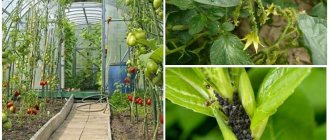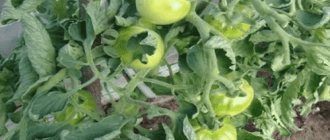Mold grows easily in warm, humid environments. However, you can control the contamination of mold spores and the spread of mold among the plants in your greenhouse. The most common types of mold that grow on plants include: gray mold, white mold (powdery mildew), and black mold.
Mold in a greenhouse
Polycarbonate structures can now be found on almost every personal plot.
In such a shelter, plants feel comfortable in any weather conditions. In the northern regions, the use of greenhouses helps to extend the season for crop ripening, and in the southern steppe regions it retains moisture and protects from the scorching sun. But there are also disadvantages to a closed microclimate, for example, mold in a greenhouse. The fungus can appear in the soil, on fruits and greenery of plants, on the surface of construction materials. What to do if mold quickly spreads in a polycarbonate greenhouse and destroys the crop?
Causes of mold in a greenhouse
Mold on the surface of the soil in a greenhouse appears as a result of:
- insufficient ventilation;
- air temperature about 20 degrees;
- lack of UV radiation (sunlight);
- excess air humidity;
- malfunction of the irrigation system.
The beneficial microflora of the soil is replaced by pathogenic ones, and the soil becomes stained. Over time, the fungus spreads through spores that settle on plants. Various diseases of fruit crops appear.
Mold on cucumbers and tomatoes in a greenhouse significantly reduces yield levels. Depending on the type of fungal colonies, white, black spots, and rot appear on the fruits. If spores get on the plant during flowering, there may be no harvest at all.
White mold can develop in a polycarbonate greenhouse due to contamination of the structure. Wrinkle all internal surfaces regularly and periodically treat with antifungal agents.
Ways to fight
The appearance of fungal colonies in a greenhouse is indicated by a musty smell, a white coating on the soil, rot on the fruit, and wilting of plant leaves. What to do if mold is found in a greenhouse?
Start the fight against mold from the soil:
- alkalize the soil by adding carbohydrate-mineral mixtures to it;
- add ash and charcoal to the soil in equal proportions;
- spray the plants with a fungicide solution (Fundazol, Fitosporin-M);
- sprinkle peat line under the plants;
- Cut off the leaves that are affected by the fungus with scissors;
- In case of blackleg disease, remove the plant.
How to get rid of mold in a greenhouse after harvest? Remove any remaining plants from the soil. There should be nothing left on the soil. All healthy “tops” are sent to the compost heap, and those affected by the fungus are burned.
A musty smell in a greenhouse indicates the presence of active fungal colonies. Air stagnates as a result of insufficient ventilation. It is enough to open windows in the ceiling and on the side walls to get rid of it.
Also, bottles of iodine hung along the greenhouse will help cope with the smell. Wiping the greenhouse glass with hydrogen peroxide will help eliminate fungus, odor and improve the penetration of sunlight.
How to remove mold from peat pots
If mold has spread over the surface of the peat pot, it will be almost impossible to deal with it. Its hyphae grow deep into the material; not a single drug will get there.
You can also try:
- Spray the walls outside and along the perimeter inside with Fitosporin or a similar preparation (Alirin B, Baxis).
- Gently wipe the pots with a soft cloth soaked in soda solution.
- Spray the pots with hydrogen peroxide.
If the seedlings are already large, then you can carefully transfer them to new pots filled with soil mixture, and burn the old containers outside the site.
Mold Prevention
The basis of prevention is compliance with cleanliness and rules of agricultural technology, as well as:
- Constant control of air humidity levels.
- Well-established method of ventilation.
- Working irrigation system.
- Good penetration of sunlight.
- Preventing stagnation of moisture on the soil.
- Disinfection of the greenhouse after harvesting.
- Spring preparatory treatment of the frame with a manganese solution or soap solution.
In the fall, when all the plants have already been removed from the soil, you can use active means of combating fungal colonies, for example, sulfur bombs, which emit smoke that penetrates all hard-to-reach places.
In order to prevent fungal infections on plants, spray them with biological products, while avoiding the flowering time, since all the chemicals will remain in the fruits.
Source: plesneveet.ru
The nature of molds
When systematizing plants in living nature, fungi are separated into a separate kingdom. There are more than 250 types of fungal organisms, which are grouped into orders and groups according to biological characteristics. In the international modern classification, mold fungi occupy the sixth order and are mainly represented by unicellular organisms, and in rare cases - multicellular. Due to the microscopic size of individual groups of fungi, they are called micromycetes.
Basically, mold accumulates and grows in large colonies, the appearance of which is represented by windy mycelia without large fruiting bodies. Many molds are facultative or obligate parasites. In other words, they are able to live independently or in the environment of the owner. Spores of such fungi are able to survive in conditions of increased radiation, in permafrost and even in space. Only certain groups die if they are exposed to temperatures above 100 degrees for at least three hours.
Scope of distribution
Molds can live and spread on soil and in water. Extensive colonies spread everywhere in moist, warm places with a suitable nutrient medium. The soil in a greenhouse is just such an environment. The health of plants directly depends on the quality of the substrate in which they were grown. If the quality of the greenhouse soil has changed, this will not have a very good effect on the growth and development of seedlings. The very first sign that white mold has appeared in the greenhouse will be a whitish coating on the surface of the soil, which is a harmful fungus.
Signs about a flower pot in a dream
When you dream of flowers in pots, this is one of the most favorable plots that predicts good luck and success in the future. Perhaps a great material reward awaits the person ahead, or he will buy expensive property. However, this interpretation is correct in the case when the flower did not fall and was dreamed of as blooming, green and fresh. If in a dream a person sees limp, dried flowers, then this may indicate troubles in the future. For example, there will be troubles at work, financial losses or quarrels in the family. When a flower falls off in a dream, it speaks of illness.
If in a dream a person dropped and broke an empty pot on the floor in the room, poured soil out of the pot, or broke it, then this may foretell discord in the family in the future, even divorce. Also, scattered earth at night speaks of illness, loss of loved ones or financial difficulties. It is worth considering that the prediction of dreams may depend on who dreamed of the flower pot. For example, if a young girl dreams of a beautiful flower, then a wedding awaits her. For older women, a blooming flower indicates a possible pregnancy, and for older ladies, such a dream promises the presence of diseases of the reproductive system.
Conditions for development
Microscopic spores are easily transported by air currents and can remain dormant for several decades. When suitable conditions arise, they begin to grow and reproduce rapidly. In this case, living plants with soft tissues (cucumbers, tomatoes, vegetable seedlings and others like them) are captured.
Conditions most suitable for mold to grow:
- Insufficient illumination (a small amount of ultraviolet rays that enter dense plantings, as well as cloudy weather without additional lighting);
- Increased soil moisture and stagnation of water after watering at the root system. This may be due to water leakage in damaged areas of the hose or due to improper watering;
- Poor or no ventilation;
- The temperature in the greenhouse is 20–22 degrees above zero;
- Indoors humidity is 95%.
Where does the greenery inside the polycarbonate honeycomb come from?
Cellular polycarbonate is a material consisting of several layers in which there are long longitudinal channels, or stiffening ribs, called honeycombs. These honeycombs contain air, due to which the weight of the material is reduced, and thermal conductivity and insulating properties are improved. However, sometimes, if the greenhouse is installed incorrectly, condensation accumulates in the honeycombs and a green coating forms - mossy mold. The reasons for its appearance are the same as for black mold - poor ventilation and high humidity. In addition to infecting the soil and plants, plaque reduces the light transmission of polycarbonate (the walls become opaque due to greenery), which again contributes to the appearance of various types of mold.
Green coating on polycarbonate appears inside honeycombs
Another option for the further occurrence of such a green coating on the walls may be the lack of a foundation under the greenhouse.
Strashnov
https://7dach.ru/user_644/stenki-polikarbonatnoy-teplicy-pokrylis-zelenym-naletom-chem-mozhno-ego-udalit-151374.html
Preventive actions
The appearance of mold is associated with the processes of decomposition of vegetation and biocorrosion. It is because of this that mold grows most strongly in the autumn. But with one-time use of anti-mold preparations, the desired result will not be achieved. To create optimal conditions for the growth and development of plants on protected soil, it is necessary to carry out a number of measures.
After harvesting in the autumn, it is imperative to disinfect the greenhouse before the next season of growing vegetable crops without seedlings. To get rid of mold on the soil in a greenhouse, you can act in several ways:
- Treat the room with FAS sulfur bomb;
- In the spring, it is necessary to repeat the procedure for treating the premises with a solution of potassium permanganate and adhesives (soap and the like), if mold was detected in the greenhouse in the previous year;
- Constantly monitor soil and air moisture levels during the growing of crops and seedlings;
- The irrigation system must be kept in good working order. Overmoistening should not be allowed. One of the indicators of waterlogging is the appearance of black legs on seedlings. In this case, the soil must be sprinkled with dry sand under the plants. It is necessary to check the greenhouse well, but avoid drafts;
- Mold does not like alkaline environments. It is because of this that the greenhouse soil, with an interval of 3-4 weeks, needs to be powdered 3 times a season under all plants with a mixture of charcoal and ash, ground into powder (the proportion of the mixture is 1:1).
If mold appears on the soil (especially on compacted soil), you can treat it with peat, represented by dry briquettes of high-moor peat. Peat contains a synthetic polymer that serves as a soil loosening agent. When it soaks, it increases several times in volume. In order to neutralize acidity in the soil, it is necessary to treat with a peat copper solution. Mineral water-soluble fertilizers are also added there.
In order to prevent damage and save plants and seedlings from fungal diseases (basal and root rot, Fusarium wilt, blackleg, etc.), 8–10 days after the plants sprout, they need to be treated with biofungicides, using preparations according to the recommendations ( Fundazol, Planriz-Zh, Gamair-SP, Alirin-B, Fitosporin-M).
The same biofungicides can be used to treat the soil under plants. You can re-treat the soil with biological products (plant and soil) after 15–20 days, unless other terms are specified in the recommendations.
If seedlings are grown at home, it is best to use specialized soils. This is especially true for beginners in gardening. This soil is specially treated against pests and diseases and fertilized according to all agrotechnical requirements.
Growing seedless crops and seedlings in home and greenhouse conditions requires unquestioning compliance with all agrotechnical measures. Otherwise, all the measures that have been applied will not have the desired result.
It should be remembered that mold is not harmless to human health. If a person stays in a room that is contaminated with mold, he may develop bronchial asthma, otitis media, allergic rhinitis, and bronchitis. When mold spores settle on the lungs, they can cause pulmonary diseases, including cancer. It is strictly forbidden to consume foods, including fruits and vegetables, that are affected by mold.
Source: 1teplica.com
Information: why the soil in the greenhouse turns green and what to do about it
It is worth noting that a lot depends on what kind of soil is in the garden bed and what substrate is used to form it, not only the appearance, but also how healthy the plants are and the quantity and quality of the harvest. With the slightest changes, both in the composition of the soil and in the parameters of temperature or humidity, a number of problems may arise with the soil in a polycarbonate greenhouse or greenhouse. Among the most common problems is mold, which appears as a white coating.
Prevention of fungus - folk remedies
Let's assume that mold and the cause of its appearance are found. How to poison it? Don’t rush to the store; maybe you already have something suitable in your household. Folk remedies can be used to treat wooden surfaces both as a preventive measure and as “first aid” when identifying a fungus that has not yet grown too much and has eaten into the wood. In this case, first remove the mold using a wire brush and soapy water, and then use one of the suggested options:
- copper sulfate solution – 300 g per 10 liters of water;
- drying oil or waste machine oil - all hot;
- burning a fresh, slightly damp board with a blowtorch until it turns dark brown. Carry out firing outside the greenhouse! Then further treat with impregnation.
To prevent the appearance of fungus “the old fashioned way,” you can resort to a solution of bleach – 400 g per 10 liters of water. Let it sit for a day so that you don’t get burned by splashes while working. Brush all wooden parts with a brush. Apply thick sediment to the cracks.
Why does the soil in the greenhouse become covered with a white coating?
The reasons why the soil in a greenhouse becomes covered with plaque can be different, but before you start taking certain actions, you need to determine what led to such consequences.
As a rule, this happens:
- Too much humidity;
- Increased acidity;
- Poor ventilation in the greenhouse;
- Oversaturation of the soil with fertilizer.
If the ground turns green and does not turn white, or moss and algae begin to appear, then this is the first sign of an excess of moisture. In this case, you need to pay attention to the level of illumination and the presence of ventilation.
It is important to remember that moss develops in the dark, and algae develops in too light an atmosphere.
Acidic soil is an excellent and favorable environment for the formation of moss, as a result of which the ground becomes covered with a green coating. Moss is a plant that consumes carbon dioxide, mineral salts and water from the soil, completely depriving the plants of power.
If there is a combination of excess moisture and high acidity, then the moss will spread at an incredible speed, and therefore you need to rush to do the treatment in order to get rid of this problem as soon as possible. At first glance, moss seems completely harmless, but it deprives crops of all nutrients, and the consequence will be their death, the occurrence of diseases and poor-quality harvests. Moss can spread throughout the greenhouse if you overfeed the soil with phosphorus fertilizer. Also, a green coating occurs due to blocking the access of oxygen to plants. Any crop needs fresh and constant ventilation. This is what makes it possible to eliminate bacteria that form on the soil and infect plants.
What to do if peat pots with seedlings become moldy
Many gardeners have already abandoned the use of peat pots for growing seedlings. As practice shows, they very often become covered with mold. A radical way is to transplant the plant into new soil and into a new container. If this is not possible, you can coat the outside of the pot with Fitosporin-M paste, and treat the soil for prevention using any of the methods suggested above.
How to remove mold from petunia seedlings or mold from strawberry seedlings? One of the above methods is suitable for this. These plants develop slowly at first, so they require special attention. It is better not to wait for mold to appear, but to properly care for the seedlings and carry out preventive treatments.
Why do peat tablets with seedlings mold? If watering the plants is moderate and all other care measures are carried out correctly, this indicates that the peat that was used to prepare the tablets has not been aged enough and has an acidic reaction. In this case, it is better not to wait for the plant to die, but to replant it in new soil.
What to do when the soil in the greenhouse turns green
Initially, in order to remove green deposits, you need not only to treat the surface of the earth, but also to carry out the so-called cleaning. If the cause of the green deposit is groundwater and round-the-clock watering, then it must be stopped until the soil dries out.
It is imperative to establish ventilation.
If the soil in the greenhouse begins to become covered with moss, then it must be eliminated using sunlight. If algae has formed, then you need to, on the contrary, block any access to light, which is done by sprinkling with sawdust or sand. A more effective way to combat greenery on the ground is to remove the top layer of soil.
Ventilation in a greenhouse is the most important step when growing crops, which will prevent not only the covering of the ground with a green coating in the form of moss, but also the formation of pathogenic bacteria.
If the soil is too acidic, then you need to:
- Spread a classic deoxidizer, such as ash, dolomite flour or lime;
- Sow green manure, the type does not matter at all;
- A month after the green manure germinates, you can safely plant seedlings of crops such as tomatoes, cucumbers, eggplants or peppers;
- After the seedlings begin to grow stronger, cut off the green manure, which can be used in the future for mulching.
Gardening experts categorically do not recommend using copper sulfate to combat moss or algae, since this radical method will remove not only pests, but also some crops, including those soil inhabitants that benefit plants. As soon as the soil is saturated with fine vitriol, you can safely remove the soil and throw it away. This is a tough method that allows you to overcome greenery in greenhouse soil, but it is better to push these options to the farthest drawer, otherwise you may lose the harvest for several years to come.
Mold has appeared on the ground in the greenhouse: what to do?
It is not always possible to get the desired result as quickly, simply and without much effort, since many problems often arise, in particular such as mold. Why do you need a polycarbonate greenhouse?
To grow crops:
In order to overcome such formation, you can use special products purchased in stores. They contain a sorbent, which increases the amount of alkali in the soil, thereby deactivating mold.
For its formation and spread, mold chooses a neutral and acidic environment.
Experienced gardeners prefer to use charcoal and ash in a 1:2 ratio. You need to sprinkle the land with this composition and loosen it. Thanks to the large amount of minerals and calcium, the fungus is destroyed.
Danger to plants
Why it is necessary to get rid of mold and not allow it to spread:
- The plant begins to get sick, as mold prevents nutrients from reaching the stems, leaves and flowers.
- The root system does not receive enough oxygen.
- Fungus in the soil can cause various flower diseases.
- Due to increased humidity, the roots of the plant may begin to rot.
If you do not fight the mold fungus, the plant will rot and die.
How to get rid of mold in a greenhouse
Getting rid of mold in a timely manner will protect you from possible health problems. Gardeners and gardeners are often faced with the problem of mold on the ground in a greenhouse. This is a type of fungus that is harmful to both humans and plants. It contains allergens, carcinogens and other toxic substances. Therefore, fruits grown in greenhouses with contaminated soil are not recommended for consumption, especially for children.
To prevent mold on the ground in a greenhouse from becoming a pressing problem, it is necessary to take a set of measures to prevent its occurrence.
This fungus appears regardless of the type of greenhouse and soil composition, and grows very quickly. Mold can be white, gray, or even pink. The most common is green mold. It's the hardest thing to get rid of.
Types of mold, their nature
Mold in a greenhouse manifests itself in the form of a characteristic coating on the surface of the soil, plants and the structure itself. This plaque is formed by colonies of unicellular and multicellular microscopic fungi, which are grouped into a separate kingdom according to the international biological classification. They are parasites that can exist both independently and within a host, and are also characterized by an increased ability to survive even in the most extreme environmental conditions.
Did you know? In France, they produce special types of cheese with blue mold, which can be eaten.
The main types of mold that can appear in a greenhouse:
- White mold. Visually, it resembles small clumps of cotton wool covering some areas of plants and soil in the beds with a thin layer. The cause of the disease is a sharp change in the microclimate conditions in the building, associated with insufficient air circulation or non-compliance with watering rules. As the infection spreads, the fungal spores form small dense areas that are dark in color. The affected plant dries out, the fruits cannot ripen and sometimes begin to rot, which leads to loss of harvest.
- Black mold. The spores of this type of fungus form a dark coating on the stem with a slight purple tint. Ideal conditions for the spread of infection are high air temperature and humidity. At the initial stage, the disease attacks the lower leaves of plants, covering them with small red spots that resemble burns. Subsequently, the lesions spread to the entire leaf, the stem turns black and the plant dies.
- Gray mold. This infection is characterized by the appearance of a grayish coating and moist dark spots on the surface of the stem, leaves and fruits. The disease often occurs in greenhouses with high soil density and improper ventilation systems. Fungal spores first infect the root part of the vegetable crop and then spread throughout the plant. As a result, the crop withers, the entire above-ground part of the bush becomes covered with a light or pink coating, and the fruits become deformed and become unsuitable for consumption.
Preventive measures
It is worth taking care of preventive measures in advance. For example, before planting seedlings in pots, it would be a good idea to treat them with a weak solution of potassium permanganate and prevent mold from occurring during the period of its growth. If, nevertheless, the seedlings are covered with mold, then you need to treat the soil with a weak solution of potassium permanganate or fungicides (phytosporin-M or foundationol) before transplanting it into the greenhouse.
The main causes of mold are the following factors: high humidity in the greenhouse, lack of direct sunlight, poor air ventilation.
In order to avoid the appearance of mold in a greenhouse, it is necessary to ventilate or artificially ventilate it daily.
Accordingly, in order to avoid its appearance in the greenhouse, it is necessary to regularly ventilate it or ventilate it artificially. This should preferably be done daily. In addition, if a large amount of perspiration appears on the walls of the greenhouse, wet areas must be wiped dry and try to avoid excessive humidity. Plants should be watered in such a way that the water on the ground and on the floor of the greenhouse does not stagnate in puddles. To maintain optimal humidity, it is better to place containers filled with water on the ground or floor. If possible, you need to open part of the greenhouse at least 2 times a week to allow sunlight to penetrate inside.
Why is it dangerous?
When the fungus gets on vegetable crops, it clogs the plant’s blood vessels and starts the process of releasing toxic substances. In the confined space of a greenhouse, they accumulate in the soil, leaves and fruits of vegetable crops, as well as in the air.
- Therefore, the appearance of mold in a greenhouse is always accompanied by the following negative consequences:
- damage to the wooden frame of the greenhouse - fungal spores multiplying in the wood provoke rotting of the material;
- contamination of all wooden surfaces inside the structure (tables, drawers, shelving) - they become unsuitable for further use, because they become covered with a layer of mold;
- death of plants and loss of harvest - a microscopic fungus destroys plantings and makes the fruits unsuitable for consumption;
- the appearance of diseases of the respiratory tract and skin in humans - when inhaling spores or eating vegetables contaminated with mold, asthma, cough or an allergic reaction may develop, accompanied by redness of the skin and itching.
